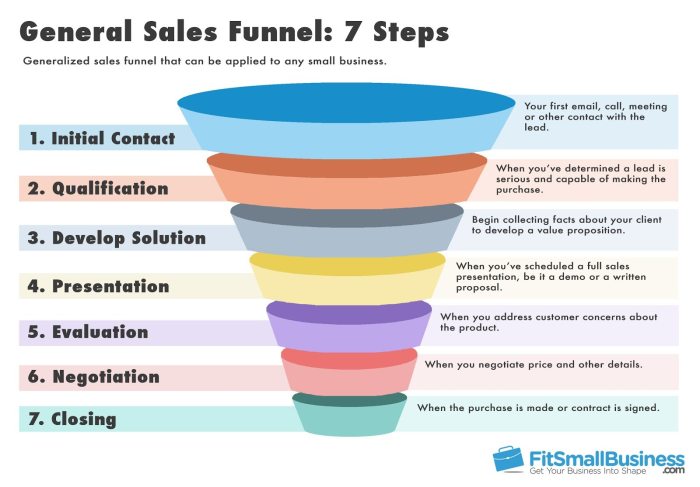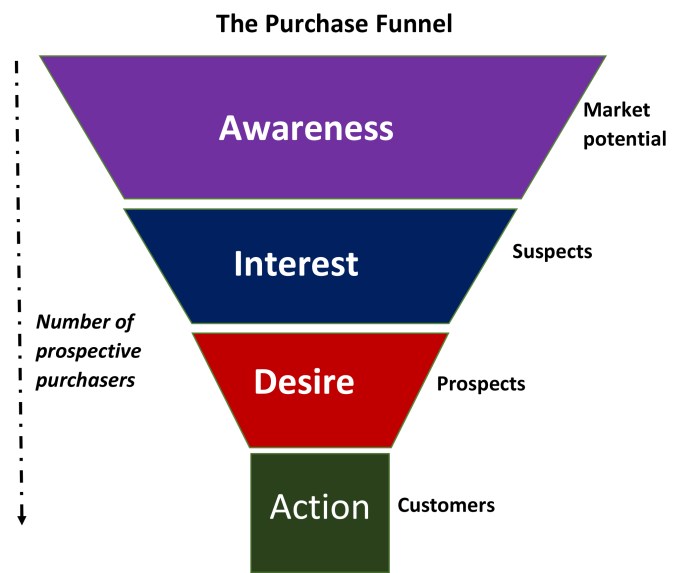Creating an Automated Sales Funnel sets the stage for a seamless sales journey, blending technology and strategy to boost your business game to the next level. It’s like having a personal assistant for each customer, guiding them effortlessly through the buying process.
As we dive deeper into the intricacies of automated sales funnels, you’ll uncover the secrets to transforming leads into loyal customers with just the click of a button.
Overview of Automated Sales Funnels
An automated sales funnel is a digital marketing strategy that uses a series of automated steps to guide potential customers through the buying process. This can include email marketing, social media campaigns, and targeted advertising to move leads towards making a purchase.
Examples of Industries Benefiting from Automated Sales Funnels
- E-commerce: Online stores use automated sales funnels to recommend products, send cart abandonment reminders, and offer discounts to increase conversions.
- Real Estate: Agents use automated emails and follow-up sequences to nurture leads and schedule property viewings.
- Software as a Service (SaaS): Companies use automated onboarding sequences and free trials to convert leads into paying customers.
Advantages of Automated Sales Funnels
- Efficiency: Automated sales funnels save time by nurturing leads 24/7 without manual intervention.
- Personalization: Tailored messages and offers based on customer behavior lead to higher engagement and conversion rates.
- Data-Driven: Analytics and tracking allow businesses to optimize their funnels for better performance and ROI.
Designing an Automated Sales Funnel: Creating An Automated Sales Funnel
Creating a well-designed automated sales funnel involves a strategic approach to lead potential customers through various stages of the sales process. It requires careful planning and execution to ensure optimal results and conversions.
Mapping Out the Funnel Stages
- 1. Awareness Stage: This is where the customer becomes aware of your product or service through marketing efforts such as social media ads, content marketing, or .
- 2. Interest Stage: Once aware, the customer shows interest in learning more about what you offer. This stage can include providing valuable content, free trials, or demos.
- 3. Decision Stage: In this stage, the customer evaluates your offering and decides whether to make a purchase. This can involve personalized offers, testimonials, or case studies to showcase value.
- 4. Action Stage: The final stage where the customer makes a purchase. This can be facilitated through automated emails, retargeting ads, or limited-time offers to encourage conversion.
Best Practices for Structuring the Funnel
- 1. Clear and Compelling Messaging: Ensure that each stage of the funnel has clear and compelling messaging to guide the customer through the process.
- 2. Personalization: Tailor the content and offers based on customer behavior and preferences to increase engagement and conversions.
- 3. A/B Testing: Continuously test different elements of the funnel to optimize performance and identify areas for improvement.
- 4. Automation: Use automation tools to streamline the process, such as email marketing platforms, CRM systems, and analytics tools to track performance.
Software and Tools for Automated Sales Funnels, Creating an Automated Sales Funnel
- 1. ClickFunnels: A popular tool for creating sales funnels with a user-friendly interface and a wide range of templates to choose from.
- 2. Leadpages: Another option for designing landing pages and sales funnels, offering customization options and integration with email marketing services.
- 3. Infusionsoft: Ideal for small businesses looking to automate their sales and marketing processes, with features for lead scoring, email marketing, and CRM.
- 4. HubSpot: A comprehensive platform that includes marketing automation, CRM, and sales tools to manage the entire funnel from lead generation to conversion.
Implementing Automation in Sales Processes
Automation plays a crucial role in optimizing sales processes by streamlining tasks, reducing manual effort, and increasing efficiency in managing leads and prospects. By leveraging automation tools, businesses can enhance their sales funnels to deliver personalized experiences and nurture leads effectively throughout the sales cycle.
Tasks that can be automated within a sales funnel
- Lead Scoring: Assigning scores to leads based on their interactions and behaviors, helping prioritize follow-ups.
- Email Marketing: Sending automated emails at the right time to engage leads and move them through the funnel.
- CRM Updates: Automatically updating customer relationship management systems with lead information and interactions.
- Follow-Up Reminders: Setting up automated reminders for sales reps to follow up with leads at key touchpoints.
- Social Media Posting: Scheduling and posting content on social media platforms to drive traffic and engagement.
Automation’s impact on efficiency and lead nurturing
Automation improves efficiency by reducing manual tasks, allowing sales teams to focus on high-value activities. It also enhances lead nurturing by delivering timely and personalized communication, increasing engagement and conversion rates. By automating repetitive tasks, businesses can scale their sales efforts, reach a larger audience, and provide a seamless customer experience.
Personalizing the Customer Journey

In an automated sales funnel, personalizing the customer journey is crucial for creating a tailored and engaging experience for each individual. By leveraging data and analytics, businesses can customize interactions at different stages of the funnel to increase conversion rates and build long-lasting relationships with customers.
Importance of Personalization
Personalization in automated sales funnels helps businesses connect with customers on a deeper level, making them feel valued and understood. This leads to higher engagement, increased trust, and ultimately, more conversions.
Strategies for Tailoring Customer Experience
- Segmentation: Divide customers into different groups based on demographics, behavior, or preferences to deliver targeted messages.
- Dynamic Content: Show personalized content such as product recommendations or special offers based on customer interactions.
- Behavioral Triggers: Use customer actions like clicks, page views, or abandoned carts to trigger personalized follow-up messages.
Using Data and Analytics
Data and analytics play a key role in personalizing interactions within the sales funnel. By tracking customer behavior, preferences, and purchase history, businesses can tailor their messaging and offers to meet individual needs. Utilizing tools like CRM systems and marketing automation platforms can help streamline this process and ensure a seamless customer experience.
Integrating Email Marketing in Sales Funnels
Email marketing plays a crucial role in an automated sales funnel by allowing businesses to nurture leads, build relationships with customers, and drive conversions. It is a powerful tool to deliver personalized content directly to the inbox of potential customers, keeping them engaged and informed about products or services.
Tips for Creating Engaging Email Campaigns
- Personalize the content: Address subscribers by their names and tailor the email content based on their preferences and behaviors.
- Use compelling subject lines: Capture the attention of recipients with creative and enticing subject lines that make them want to open the email.
- Include a clear call-to-action: Guide recipients on what actions to take next, whether it’s visiting a website, making a purchase, or contacting the business.
- Optimize for mobile: Ensure that your emails are mobile-responsive so that recipients can easily view and interact with them on their smartphones or tablets.
- A/B test your emails: Experiment with different elements such as subject lines, content, images, and CTAs to identify what resonates best with your audience and improves engagement rates.
Segmenting Email Lists for Targeted Marketing
Segmenting email lists allows businesses to send relevant content to specific groups of customers, increasing the likelihood of conversion and engagement. By dividing subscribers based on demographics, behaviors, purchase history, or engagement levels, businesses can create personalized email campaigns that cater to the unique needs and interests of each segment.
Measuring Success and Optimizing Funnels

When it comes to automated sales funnels, measuring success and optimizing them is crucial for driving better results and maximizing conversions. By tracking key metrics and analyzing data, businesses can identify areas for improvement and make necessary adjustments to enhance the overall performance of their sales funnels.
Key Metrics for Tracking Performance
- Conversion Rate: Measure the percentage of visitors who take the desired action, such as making a purchase or signing up for a newsletter.
- Engagement Metrics: Monitor metrics like click-through rates, open rates, and time spent on pages to gauge customer interest and interaction.
- Sales Cycle Length: Track how long it takes for leads to move through the sales funnel to identify bottlenecks and areas for streamlining.
Analyzing Data for Optimization
- Utilize Analytics Tools: Use tools like Google Analytics to gather data on visitor behavior, traffic sources, and conversion rates for insights into funnel performance.
- Identify Drop-off Points: Analyze where leads are dropping off in the funnel and determine possible reasons for high exit rates to make necessary improvements.
- Segmentation Analysis: Segment leads based on behavior, demographics, or other criteria to personalize marketing strategies and improve targeting.
A/B Testing and Continuous Improvement
- Implement A/B Testing: Test different elements of the sales funnel, such as headlines, CTAs, or email copy, to determine which variations drive better results.
- Iterative Optimization: Continuously make small tweaks and improvements to the funnel based on data and test results to optimize performance over time.
- Feedback Loop: Gather feedback from customers to understand pain points and preferences, then use this information to refine and enhance the funnel experience.
